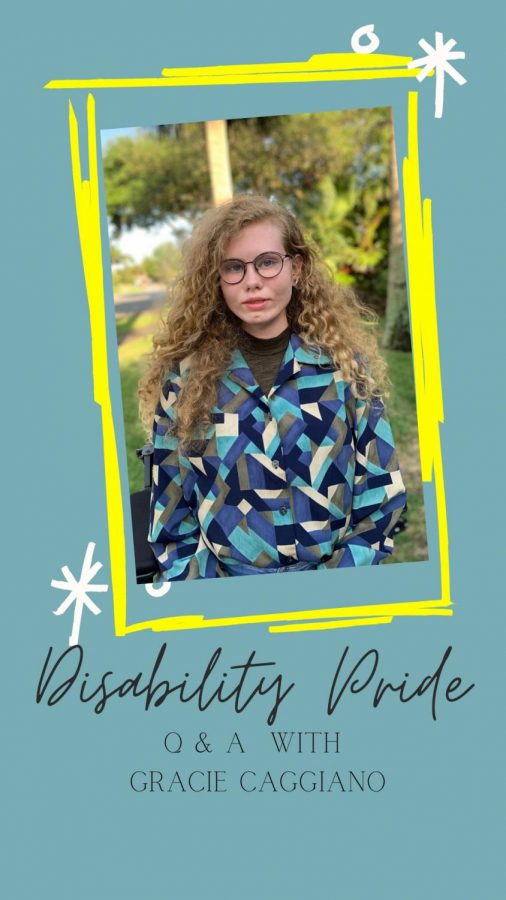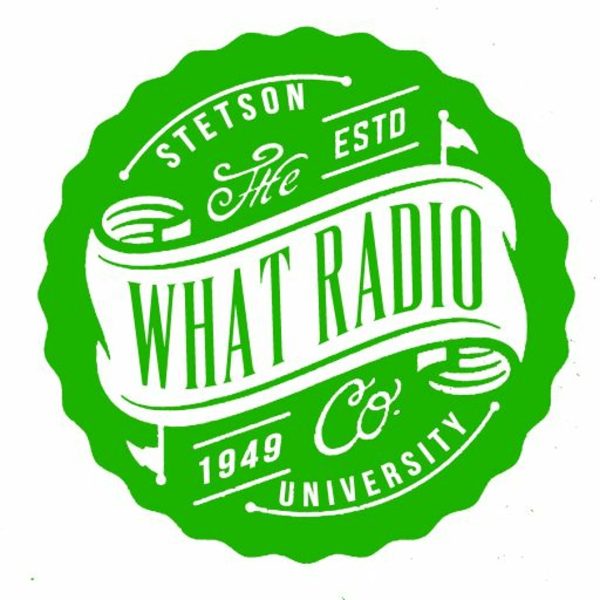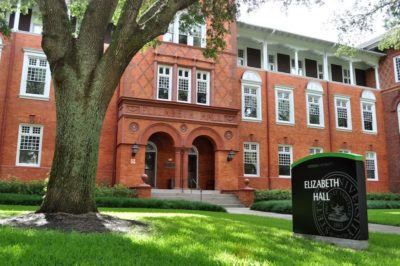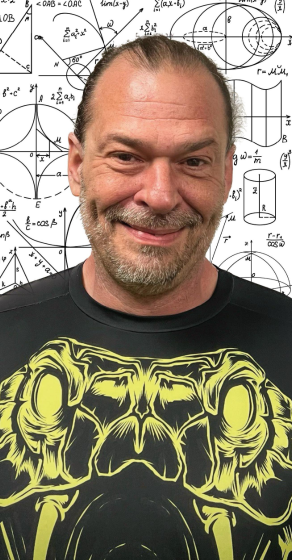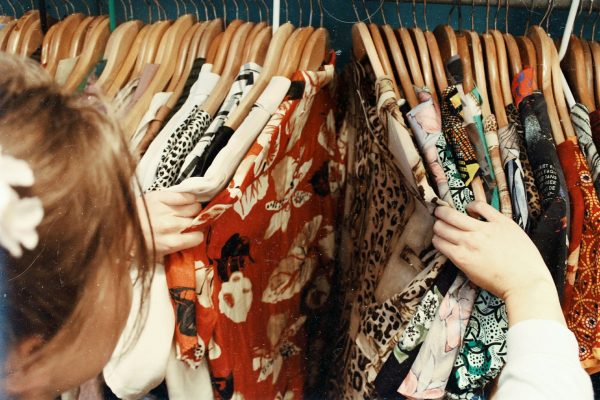Disability Pride Month: A Q&A with Gracie Caggiano
Editor’s Note: An early draft of this story was published accidentally before it was fully edited. Hatter Network regrets that error. The following piece has been updated with corrected information.
July is Disability Pride Month, a time set aside to “promote visibility and mainstream awareness of the positive pride felt by people with disabilities.” The celebration coincides with the anniversary of the passing of the American Disabilities Act, colloquially known as the ADA, in July of 1990.
July 26 marks the 30th anniversary of the signing of the bill, which is a piece of civil rights legislation that protects individuals with disabilities from discrimination in public spheres such as schools, sports, jobs, and transportation.
We sat down with Gracie Caggiano ‘21, a music composition major and member of the disabled community who utilizes a wheelchair, to discuss the importance of celebrating Disability Pride Month and her experience as a disabled student on Stetson’s campus.
This conversation has been condensed and edited for grammar and clarity.
Hatter Network: So July’s Disability Pride Month, and [Sunday was] the 30th anniversary of the day the ADA got officially put into legislation. Can you talk a little bit about how specifically Disability Pride Month plays a role in your life, and how that has impacted you?
Gracie Caggiano: Yeah, of course. So, I actually did not know that Disability Pride Month existed until this year, but it has been a bit of a journey. Of course, being a disabled person, and sort of coming to terms with having a disability– but not necessarily in the pitiful way that sometimes that can be portrayed by media– but more like accepting your body. And claiming it as well. And so disability pride to me has helped a lot with that. So like, claiming my body, accepting my body– this is the body I have and it does its job and it’s a great body. And I can take pride in it and I don’t have to be ashamed of it.
So disability pride has helped me realize that I am still worthy of love in the same way that any other human would be, whether they’re disabled or able-bodied, and it’s also helped me develop an understanding of other disabilities as well. Because the disability community is the most diverse identity group, because you have physical disabilities, you have emotional disabilities, or mental disabilities, intellectual disabilities, there’s so many different types of disabilities and they’re all worthy of celebration, and everyone should be able to claim their disability and be like: “this part of who I am.”
And so, then, disability pride, being able to claim yourself and recognize your worth further helps to help you feel empowered to ask for accessibility or accommodations that you need, because disability is then viewed in a different light. You’re not internalizing all that hatred toward yourself, you’re able to ask for the things that you need. Like, “Hey, I want to ramp put in this building because it should have a ramp,” you know, like, things like that. It’s just a lot easier to ask for those kinds of things when you value yourself, and when other people who don’t belong to the community also value you. Then they’re more likely to give you those accommodations or that accessibility that you need.
HN: So do you think– because you said this is the first time you’re hearing that July’s Disability Pride Month– so is this something that you wish was more broadly advertised or celebrated on a national scale, the way Pride Month is, or Black History Month?
GC: I do. I wish it was more legitimized than it is. Because people, I feel like we have this idea that disability is a negative thing. Whereas like, your sexuality, or your race is not really a negative thing. But people will look at the disabled community and they’re like, ”Oh, that’s so sad.” And that’s why they’re like,”Why do you have pride in your disability?” And I feel like because of that idea, it’s not very legitimate, and that’s why it hasn’t been so broadly advertised, because it’s like, well, this is– this is tragic, isn’t it? To have a disability, it’s tragic, right? Not really. And I feel like, it’s like, it’s kind of like a push and pull. There’s that idea that’s preventing it from being more broadly accepted as a legitimate move– not necessarily movement, but like celebration, I guess. But that’s also the idea that we’re trying to get rid of by having disability pride. So I do wish that it was pushed a little bit more. And like, this interview, for example, is a great start to that. You get the word out in smaller communities and it continues to grow.
HN: So, with things like Disability Pride or things that, you know, try to reestablish the idea where “my disability isn’t this tragic occurrence, it’s this part of my identity and it’s a thing to be positive about,” do you think things like Disability Pride Month work towards destigmatizing disabilities in that way? And reshaping, potentially, those stereotypes able-bodied people might have?
GC: Yeah, I think it does. Of course, you know, there hasn’t, I haven’t had the personal experience much, but if you look in the history of disability rights, and you [look] , back in the ‘90s, in the U.S. and the UK, there was sort of this celebration of disability culture, which ended up in further support of ADA and the UK equivalent of ADA. And so, 1990, and then 1995, respectively, in both countries, and it’s because there was that celebration of disability culture. There was that destigmatizing of the idea that disability is tragic and that we should either pity disabled people or use them as inspiration machines, if you see what I’m saying. There only seems to be two views, but then when you get the celebration, this, this pride, this acceptance that this is like, this is a natural part of my life, and, you know, I shouldn’t be able to claim that, it does destigmatize the idea that disability is either pitiful or something to be inspired about.
HN: You mentioned the ADA, and like I mentioned in the beginning of this, the 30th anniversary of it being passed in July of 1990, you know, that’s coming up. So, in as much detail as you’re willing to share, can you talk about ways that the implementation of the ADA, and then later in 2009, the ADAAA, have impacted you?
GC: Hmm. Okay. So I obviously was born after the ADA was passed, and I was actually not diagnosed with my disability until I was about nine or 10. So I essentially grew up in a world where it was commonplace for new buildings or renovations to have to comply with ADA. And so that means that there’s more access for me in public spaces– or people like m – other people with disabilities. There’s more access, because now you’re required to put a ramp in the front of this building if you’re going to have stairs, or you’re required to have a working elevator, or you’re required to make at least one of your bathrooms big enough for me to fit my wheelchair in it. And of course, there are other details that go into ADA. But I grew up in this world where new buildings and renovations, if– I say that lightly because it has to be at least 20% of the building renovated to follow ADA– but I grew up in this world where there was more access being implemented. And so, that means things like I’m able to go out and develop new interests because I can access it publicly. Or I can go to school, because I can access it publicly. Of course, things aren’t perfect and there’s still a long way to go, but if [the] ADA hadn’t been passed, I probably would have been struggling a lot more to access the same things that are able to access today.
HN: So I know you mentioned, with, you know, it’s great new construction or things that are being renovated, as long as it’s at over 20%, you’re complying with ADA, which means you have access or other people with disabilities have access. Can you talk a little bit about, specifically for our reference point at Stetson, for example, we have quite a few historic buildings that have not been renovated, especially recently, and I know there’s, a big push from students with disabilities on campus– or just faculty and administration with disabilities on campus– for buildings that are older that right now aren’t super compliant with ADA– specifically, I think Elizabeth is the big one where it doesn’t have an elevator, it doesn’t– so really the first floor is only accessible. Have you found that Stetson is working to comply with those things that you know, for a historic building, they’re less likely to comply? Can you talk about that situation?
GC: So, I think there’s a lack of conversation about accessibility at Stetson. Because we talk about inclusion all the time, but are we talking about including people with disabilities, or faculty or students with disabilities, really, or is there this value over history? And I feel like that conversation isn’t really being had right now. I know that I haven’t personally been involved in the push for these renovations because I came to Stetson and it was like, “Oh, yeah, you know, we’re an inclusive campus and you should be able to get all the accommodations that you need.” But I didn’t realize how inaccessible Stetson was until I got here. And I had heard of students pushing for an elevator in Elizabeth Hall, and it was sort of like, “Oh, our building is pretty historic. We don’t really want to do that.” But there’s no saying like, exactly who is saying this building is too historic. Is it the trustees? Is it our administration? Or some alumni who just really like, love that building– because it’s a gorgeous building. I personally think it would be prettier if it had an elevator, but–
So I can’t say if I know that Stetson is being compliant with ADA or not. I mean, technically you saw the renovations in the CUB. That’s ADA compliant. It’s very much ADA compliant. They’ve got elevators on like, either side of the entrance. The bathrooms are awesome. They’re definitely ADA compliant. There’s automatic door buttons, which you know, they’re a little finicky, but like, for the most part, the renovations are definitely ADA compliant. So that, like– they’re following ADA there, because at least 20% of the building is being renovated. Right, so they have to follow ADA there. The Welcome Center– another newer building, ADA compliant. Their bathrooms are ADA compliant. They’ve got an elevator. They’ve got automatic door buttons, the doors are wide.
So it’s like, you can see those two buildings that they’re following it, but the older buildings I feel like, to just like– maybe it doesn’t matter that much to them. I mean I can’t say I know for sure. Because again, I feel like this conversation hasn’t really started yet. And I’m hoping that it will now, but there’s definitely a lack of accessibility in the majority of Stetson’s buildings and even their accessible entrances are not really accessible. I mean, Sampson Hall has a ramp and then a really heavy door without an automatic door button, and they call that an accessible entrance. Elizabeth Hall has a– you know, it’s a pretty nice ramp, but the door opens up to the ramp, so it’s really hard to get around the door and then into the door. So there’s a problem with the infrastructure there. And I don’t know, again, the doors aren’t automatic, so I don’t know if they call that an accessible entrance. Same thing with Allen Hall. I mean there’s a ramp up there but the doors are very narrow, and the doors are kind of hard to open and there’s no automatic door button. So it’s things like that. Can you really call it an accessible entrance? And if you’re going to call it an accessible entrance, can you at least put an automatic button on it? Like that sort of thing.
HN: So you mentioned that you think there’s a lack of conversation going on about this specific kind of inclusion at Stetson. What are ways you think, either on a student or faculty end, or on an administrative end, that we could– we as in Stetson– could start the conversation?
GC: Yeah. Well, for one, I think this interview, or this article is a great start because, you know, I’m thinking that a pretty good percentage of the student body reads these articles. And so it’s like, this is the communication of an idea. I think it would be helpful to have, I guess sort of like an organization, or a seat reserved at [the] Multicultural Student [Council] for the disabled community, because disability culture is culture, right? And that way we can have cultural credit events where we’re talking about, “Okay, what is disability legislation? What’s the history of disability rights? What kind of struggles do we face in trying to break down these social and physical barriers?” It’s like, education from people who experience it is super important, because like, if you’re just like, looking on, and an able-bod[ied] person tells you like, “Hey, yeah, your disability rights is the thing.” You’re not gonna understand it as much as you want from the point of view of a person who has a disability.
And so I think if we, and this might be at the fault of the disabled student population, maybe being too afraid to speak up, or like, I know, I certainly have been a little bit afraid to speak up about anything, because I don’t want to have a chip on my shoulder. And, you know, I try to be grateful for the things that I do have. But there’s a lack of conversation, definitely, and if we could start that conversation, in the same way that we talk about other cultures, and other issues that go on on campus, I think it would be super beneficial.
I also– with having a new president, I plan on contacting him personally and being like, “Hey, do you want to tour the campus of me in a wheelchair and see what it’s like from my point of view?” Because that’s like– that’s planting a seed for ways for him to understand. He talks about listening a lot– listening and learning in this tour that he’s having, listening and learning to the students. And I very much think he’s an open man– open to ideas and to transparency and communication and all of those things. And I love to be able to have this very personal conversation with him, be like, ”Hey, I want you to experience it from my point of view.” Because if he understands it, then, you know, the idea might be communicated to other administrators or to the Board of Trustees.
Accessibility and accommodation, unfortunately, is expensive. It’s not cheap to, you know, renovate buildings, or to put it in a new elevator. It’s not, but neither are other things that we add to our campus, right? So, like a new fountain. Of course, it was donor-funded, and that donor designated those funds for the fountain. But I wonder if there’s a conversation with these donors who donate these funds, who want to see our campus become more beautiful if they would donate to something like accessibility, rather than cosmetics. Because if they were able to have this conversation and understand that accessibility and inclusion is really what makes a campus beautiful, I think that they might designate some of their funds to those kinds of projects, rather than other kinds of projects, like cosmetic projects. And so I think there’s like, conversation that needs to happen in a lot of ways. And it’s like a complex webbing, it will all come together and I know it’ll take a long time. It’ll take a lot of money. It will take a lot of understanding that history, in essence, with the lack of inclusion, though it sounds harsh, is a history of ableism. And we shouldn’t value history of ableism more than we value the present need for access. So, yeah.
HN: Oftentimes, we’ve seen with both this specific piece of legislation and other types of legislation that refer to other minorities– like either [in regards to] race, gender, sexuality– that when a piece of legislation is put in place, oftentimes people outside of that minority assume that the problems that it was meant to address have been largely fixed, that there’s no more work to be done, that the legislation got passed and, even if it’s taking time, it’s doing what it’s supposed to be doing. For you specifically in regards to the ADA, and being a person with a disability, especially on a college campus that does have historic buildings that potentially– that history is being valued. Have you found that that’s true, that even slowly they’re working towards addressing those issues or, do you still run into issues of ableism– even though they might be a little harsh– but, things that still haven’t been accommodated for you or other students with disabilities?
GC: It’s hard for me to say if something is ableist or not, um, in my experience, I mean– it’s difficult, it’s a tricky answer to give because Stetson is a private college, right, and so on a public campus, it might be a little bit different with accessibility and things of that sort. But if we’re going to just define the term ableism real quick, just so we are clear about what ableism is, it’s, it’s like, in the same way that we understand racism or sexism, ableism is discrimination of a person or a group of people on the basis of their ability or lack of ability, right? So, if someone is being ableist they are being discriminatory toward a person with a disability.
HN: So would you say– I’m sorry, I don’t mean to interrupt, but I just want to make sure we clarify the term, because I think a lot of people maybe don’t know, or understand really the definition even if you know, from context clues, they can understand what it means. So would you say that ableism is an active form of discrimination, rather than just something hasn’t been fixed yet, but there is a chance it could be or, does that fall somewhere in between?
GC: You know, if something– if there’s plans to fix something, and it’s not, like that’s not already accessible, but there’s a plan to fix, there’s a plan to make it accessible, I wouldn’t say that there’s ableism there. I mean, there’s a history of ableism, right? But we’re, we’re reworking it so that it’s no longer there. But ableism is also present like, if you use an infamous slur, such as the r-word, or if you say, “Oh, that’s so lame,” or something like that. It’s like the same as any other type of discrimination. There’s lots of little pieces to it, there’s microaggressions, there are like generalizations about the disabled community and how you act toward a disabled person because of those generalizations. There’s lack of accessibility, like in infrastructure– that can be considered ableism. It’s paying a disabled person less because you think that they’re less capable of getting the job done, or that they have less to contribute.
So there’s a– there’s a lot of tiny pieces. It’s about the interaction between an able-bodied person and a disabled person, or even between two disabled people with different types of disabilities. Making discriminatory comments or treating somebody differently on the basis of their disability. So it’s about interaction between people, and it is about infrastructure as well, like refusing to make a reasonable modification. In fact, that’s a part of the ADA as well, I believe, there’s a section about reasonable modifications. So there’s multiple aspects to it. I don’t know if I’m answering the question correctly.
HN: I mean, there’s no correct answer. I’m just happy to hear your thoughts on it.
GC: Yeah, so, yeah like discrimination can come in various forms. And you see that with other types of discrimination like racism, or sexism or homophobia, or any of those types of discrimination. We can do the same thing with ableism. It can be physical, it can be social. Yeah, just based on the generalizations that we have developed as a society, about the disabled community, and then how we go about treating people with disabilities because of that.
HN:So, to wrap this up, I want to know if you had something you wanted to say, to the administration or the people making decisions for disabled students on campus regarding accessibility and inclusion, what would you say to them, and also to incoming freshmen that potentially have disabilities, what would you say to them about the Stetson experience, and what they can do, maybe to make their lives a little more accessible on Stetson’s campus?
GC: So, if I were to speak to the administration about accessibility, I think I would, in the most respectful way, because I am grateful for the experience that I have, and I don’t want to be too negative, I just want to, want to push for change, because we should also, you know, like, always be learning and pushing for change, because that’s what our society as a whole means, and we can start in our community. I haven’t had the most enriched experience that I could have if the campus was more accessible. I mean, we talk about things like, Values Day or Stetson Showcase and our campus– or even cultural credit events, right? So our campus isn’t 100% accessible. So there are events that I can’t go to on Values Day because it’s on the third floor of Elizabeth, but maybe I would have been really interested in hearing what this– what this presentation was about, or I want to be a part of the conversation, but I can’t be physically there, so I can’t be a part of the conversation.
There are things that I’m not learning that I should be or could be learning because of a lack of accessibility. And I think that every student should have a right to learn everything that they want to learn, or at least have the option to choose if they want to engage in that conversation. And I don’t have that right as a Stetson student, because I can’t access every building. When it comes to classes, you know, they’ll move a class for you if you can’t access your class, so it’s not like– on the academic level that I can’t learn everything I want to learn, because if there’s a class I need to take they’ll move it to an accessible location.
But in other contexts, such as Values Day or Stetson Showcase, I can’t engage in that community bonding, being part of that conversation in the same way that other people would be able to. And I feel like there’s just a lack of awareness about that, like that doesn’t cross their mind when they think, “Oh, like we love having Values Day and we love being an inclusive campus and talking about our values of global citizenship and how we can be this strong community,” but they aren’t thinking that there’s a lack of bonding because they’re not able to include their students that use mobility aids or they might have an invisible disability and really struggled to get up those steps and Elizabeth Hall, for example. So if they understood that we feel like we’re being left out of conversations and community bonding, and thus lacking a part of our Stetson experience that we’re promised when we come into the school, I think that they might reconsider their value of this history, and talk about accessibility a little bit more.
So, yeah, I think that’s what I would want to communicate to administration. I mean, there’s just part of your college experience that you have to accept that you won’t have at Stetson as a disabled student. I mean, being a music student, I’m in choir, I love being in choir, I love singing. But we have Lee Chapel in Elizabeth Hall. And it’s– I like the space, I think the acoustics are fun for vocal things, and we have our beautiful Christmas candlelight series mostly every fall, probably not this fall. But there’s a choreography to that, where one choir moves off the stage and another choir moves on and then you’ve got choirs in the balcony, but I’m not really involved in that choreography, like the other students are because I can’t get to the balcony. So it’s not like they don’t include me at all. They’re just like, “Hey, you know, you can hang out on the stage. Like, that’s cool. You’ll be the spotlight, right?” But it’s like, yeah, I mean, I guess that’s cool, but to be involved in the choreography in the same way that the other students are, to have a little bit more ease in moving around the stage during that event, it would enrich my experience, even more than it is being right now.
So it’s not to say that I’m not having a great Stetson experience, but I think that there are more aspects to it that can make it even better if things were accessible. I wouldn’t feel left out, or, you know, I would feel like I’m closer to the community. And I would feel like I have more options, like if I wanted to join a sorority and live in a sorority house, the sorority house on site are, to my knowledge, probably not accessible. And so I couldn’t be a part of that community bonding if I wanted to be part of that community bonding. And I feel like community is this thing that Stetson pushes– as they should– because community is great and this is how we learn to be functioning and good citizens in society, right? We learn community while we’re in college. And I don’t have the same community experience that an able-bodied student might have, because of this lack of accessibility. So that’s what I would want to comment to the [administratration].
As for incoming students who have disabilities, I think I would just encourage them to not approach things the same way that I did when I came on campus. So there’s not many disabled students that– or visibly disabled students, at least on Stetson’s campus. So I didn’t have anyone come in while I was coming in and tell me like, “Hey, you don’t have to be silent and just accept what they give you. You’re allowed to use your voice. That’s your right.”
You know, I feel like as Americans, we generally think we have this freedom of speech, or what we’re allowed to speak up about what we think, and I very much did not think that when I came into Stetson, and it goes back to this idea of internalized ableism, which is why, you know, coming full circle, disability pride is great. So you’re allowed to have value in yourself, and you’re allowed to accept your disability, and that doesn’t make you any less worthy of having a voice. So I want to encourage these disabled students coming in, to continue having that conversation, to speak up when they feel like they’re being discriminated against, to push for accessibility, to remind people of what inclusion means, and the definition of inclusion versus accommodation, and how we can be a truly inclusive campus. To not feel like they’re less worthy of having a voice– to be loud because you’re allowed to be loud– and to keep pushing for change.
Every new class that comes in is the future, and if we want Stetson to be a fully inclusive campus, or a fully accessible campus, we need our future to speak up and not shy away about these kinds of things. And I think that if I would have spoken up sooner, that my experience could potentially have been a little bit different. But I was too afraid to speak up. I felt like I didn’t have the same right, because I had this idea inside of me that I have to be quiet. Like, I have to just be grateful for what I do have. And I’m grateful for what I do have but that doesn’t mean that I’m not allowed to ask for more. It’s okay to ask for more. It’s okay to ask for help, these kinds of things need to be normalized. And I would want those incoming disabled students to feel like it’s normal to ask for accessibility and to continue to educate the community on their needs that should be respected as just means and not a burden. So, yeah, that’s what I’d want to say to incoming students.
HN: I just have one little follow-up question because I thought it was interesting that you brought it up. The difference between inclusion and accommodation, because I think potentially that’s– you mentioned there’s a lack of conversation– and potentially, maybe that’s where part of the discussion isn’t happening is where those things are different for people that aren’t disabled and aren’t you know, inside of that dealing with that every day. So can you talk a little bit about what you see is the difference?
GC: So when it comes to any community, I feel like, in general, in society we’re accommodating. So we’re taking the space that’s for the default, right? White, cis, heterosexual, maybe Christian, you know, able-bodied male, right? So we have this default, not actually a default, but what we’ve been conditioned to think as default. And it’s like, when we’re accommodating, we’re taking this– this default, and we’re twisting it a little bit so that other people can survive, but not necessarily thrive. So, with respect to the disability community, it’s like, we’re going to move their classrooms so that you can access it.
But, the idea okay, to be more clear, the idea that differentiates inclusion from accommodation is that inclusion is where the administration or the people in charge of the infrastructure, or– you know whether that infrastructure is physical or social– they’re already thinking, we have so many diverse students, or there’s so many diverse people in our community. And we’re going to think of all of them so that when they come here, they don’t have to ask for anything. They’re already included. Accommodation is saying that if a student comes to us, or a person comes to us and says, I need this to be able to survive in this community or to live in this community, accommodating them is giving them what they asked for. Inclusion is when that thing is already there. There’s no change that has to be made. They’re already included. Accommodation is changing whenever it’s been asked for. And accommodation, the tricky thing about accommodation, is that the person who’s being asked for an accommodation gets to determine if, like what kind of accommodation actually needs to be given. So they might say, “That’s not reasonable, but we can offer you this.”
So they’re accommodating, which is great, because that is access to an extent. But if there’s inclusion, they’re already considering every diverse person, they’re already considering all the possibilities that they need to consider, that way when someone who differs from this so-called default comes in, they already have what they need. There’s no need to ask for it. And that’s the difference between accommodation and inclusion.
Fast Facts on the ADA and Disability Pride:
- Justin Dart is considered the “Father of the ADA” because during the 1980s he was recognized throughout the U.S. and brought attention to the necessity of such legislation.
- In 1990, The first Disability Pride Day was held in Boston, MA the year the ADA was published and in effect. Since then there have been celebrations and parades.
- Disability culture is well-connected and relevant to the arts. Disability art is defined as art that is created by disabled people to express their experience with being disabled.
- During the 1980s and 1990s, in both the U.S. and the UK, there was a disability arts movement to help with normalizing disability and challenged the negative views of disability culture. These movements contributed to the ADA being passed in 1990 and the UK’s Disability Discrimination Act being passed in 1995.
- In 2004, The Individuals with Disabilities Education Act (IDEA) was passed in 2004.
- In 2014, The Achieving a Better Life Experience (ABLE) Act.
- This Act ensures that disabled individuals receive public education properly and are able to save money without losing government-funded insurance due to the price of healthcare.
- Disability Pride Day was first celebrated in Boston in 1990, and the first Disability Pride Parade was held in Chicago in 2004.
Resources:
-
- This article explains the chronology or history of the ADA.
- These websites explain the ADA:
- The resources webpage of the National Disability Arts Collection and Archive (NDACA) provides informational links about the Disability Arts Movement.
- The American Disabled for Attendant Programs Today (ADAPT) website
- The Disability Community Resource Center (DCRC) website

Hannah Zeller was the Executive Editor of The Reporter from 2019 to 2020. She is an ardent consumer of baked goods, a connoisseur of reality television,...


